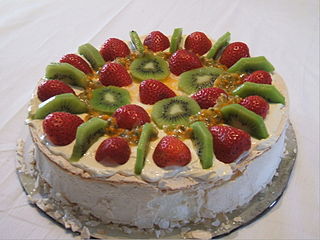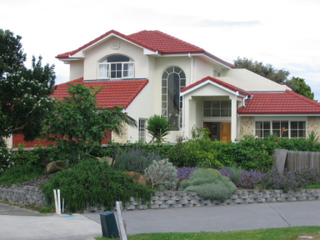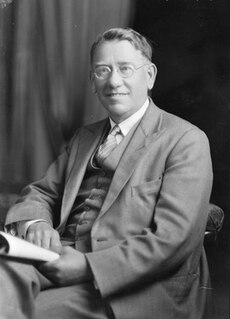
Pavlova is a meringue-based dessert. Originating in either Australia or New Zealand in the early 20th century, it was named after the Russian ballerina Anna Pavlova. Taking the form of a cake-like circular block of baked meringue, pavlova has a crisp crust and soft, light inside. The confection is usually topped with fruit and whipped cream. The name is pronounced, or like the name of the dancer, which was.

Austin Vernon Mitchell was a British academic, journalist and Labour Party politician who was the member of Parliament (MP) for Great Grimsby from a 1977 by-election to 2015. He was also the chair of the Labour Euro-Safeguards Campaign.
The Dunedin sound was a style of indie pop music created in the southern New Zealand university city of Dunedin in the early 1980s.
In Australian and New Zealand English, a quarter acre is a term for a suburban plot of land. Traditionally, Australians and New Zealanders aspired to own a 3- or 4-bedroom house or bungalow on a section of around a quarter of an acre, also known locally as the Australian Dream or the New Zealand dream. The land was frequently put to use with vegetable gardens, fruit trees, or lawns for family recreation.

Hongi Hika was a New Zealand Māori rangatira (chief) and war leader of the Ngāpuhi iwi.

Thomas Oliver Newnham was a New Zealand political activist and educationalist. He was involved in several left wing causes: attacking institutional racism in New Zealand, and opposing the 1981 Springbok Tour and apartheid in general.
The New Zealand Alpine Club (NZAC) was founded in 1891 and is one of the oldest alpine clubs in the world. The NZAC is the national climbing organisation in New Zealand and is a member of the Union Internationale des Associations d'Alpinisme. It has over 4000 members who are spread across twelve sections, eleven in New Zealand and one in Australia, plus members in other countries. It runs a national office based in Christchurch.
Social class in New Zealand is a product of both Māori and Western social structures. Researchers have traditionally discussed New Zealand, a first-world country, as a "classless society", but this claim is problematic in a number of ways. Since at least the 1980s it has become easier to distinguish between the wealthy and the underclass in New Zealand society.

The New Zealand dream centres on the acquisition of a family house on a quarter-acre section, with at least one motor vehicle. The New Zealand dream resembles the Australian Dream. For many New Zealanders this dream could also include a pleasure boat, a bach and a holiday at the beach.
Thomas Rowley was an early settler in Canterbury, New Zealand. His father was a member of the Canterbury Association and Dean-designate for ChristChurch Cathedral, but never came to the colony. Thomas Rowley and one brother emigrated, and he became a significant runholder. He later started acting as an agent for absentee landowners. He briefly served as a Member of Parliament for one of the rural Canterbury electorates. Rowley was active in church matters and married a daughter of Octavius Mathias, the first vicar of the Church of St Michael and All Angels. After 11 years in New Zealand, he returned to live in England.

Jessie Mackay was a New Zealand poet, journalist, feminist and animal rights activist. She is often referred to as New Zealand's first local-born poet and was one of the earliest writers to have a distinctly New Zealand style.
The 1947 New Zealand rugby league season was the 40th season of rugby league that had been played in New Zealand.

Mona Innis Tracy was a New Zealand children's novelist, journalist, poet, short-story writer, and community worker. She was best-known for her three children's novels, published between 1927 and 1930, which were adventures set in historical New Zealand.

Harry Hugo Tombs was a New Zealand printer, publisher, musician, artist and patron of the arts. In the 1960 Queen's Birthday Honours, Tombs was appointed an Officer of the Order of the British Empire, for services to art and music.
Thomas Vernon Griffiths was a New Zealand music teacher, lecturer and composer, known for his dedication to music in schools and the community.

Brigadier General Charles Henry Jeffries Brown DSO was a New Zealand Military Forces officer who served in the First World War, firstly in the Gallipoli Campaign and then on the Western Front. He was commander of the 1st Infantry Brigade from February 1917 until he was killed by artillery fire on 8 June 1917, one of three New Zealand brigadier generals who died during the war.

Brigadier General Harry Townsend Fulton, was a British Army officer who served with the New Zealand Military Forces during the Second Boer War and First World War.

Sheep farming is a significant industry in New Zealand. According to 2007 figures reported by the Food and Agriculture Organization (FAO) of the United Nations, there are 39 million sheep in the country. The country has the highest density of sheep per unit area in the world. For 130 years, sheep farming was the country's most important agricultural industry, but it was overtaken by dairy farming in 1987. Sheep numbers peaked in New Zealand in 1982 to 70 million and then dropped to about 27.6 million. There are 16,000 sheep and beef farms in the country which has made the country the world's largest exporter of lambs, with 24 million finished lambs recorded every year.

Christmas traditions in New Zealand are similar to those in Australia in that they incorporate a mix of British and North American traditions, such as Christmas symbols featuring winter iconography. However, the timing of Christmas occurring during the Southern Hemisphere's summer season has resulted in the development of some local traditions as a result of the warmer weather. New Zealand Christmas dishes include summer fruits and vegetables, and pavlova. The New Zealand Christmas tree, the pōhutukawa, is displayed as well as the traditional Northern European tree.
Airini Elizabeth Woodhouse was a New Zealand community leader, historian, and author.












